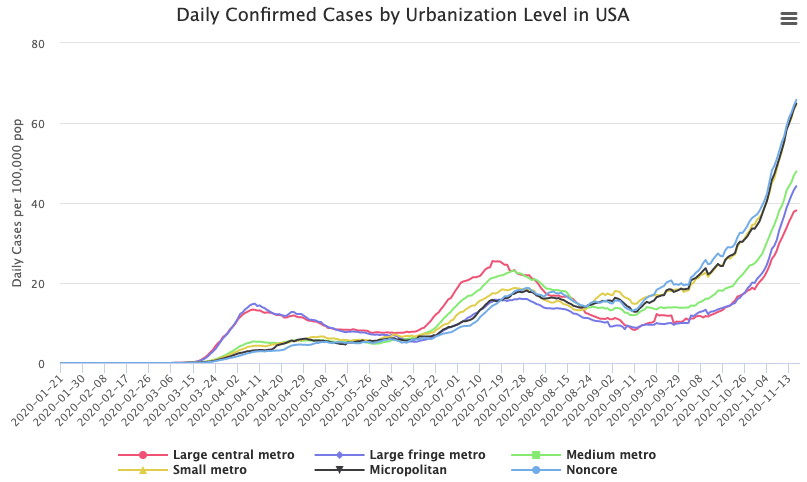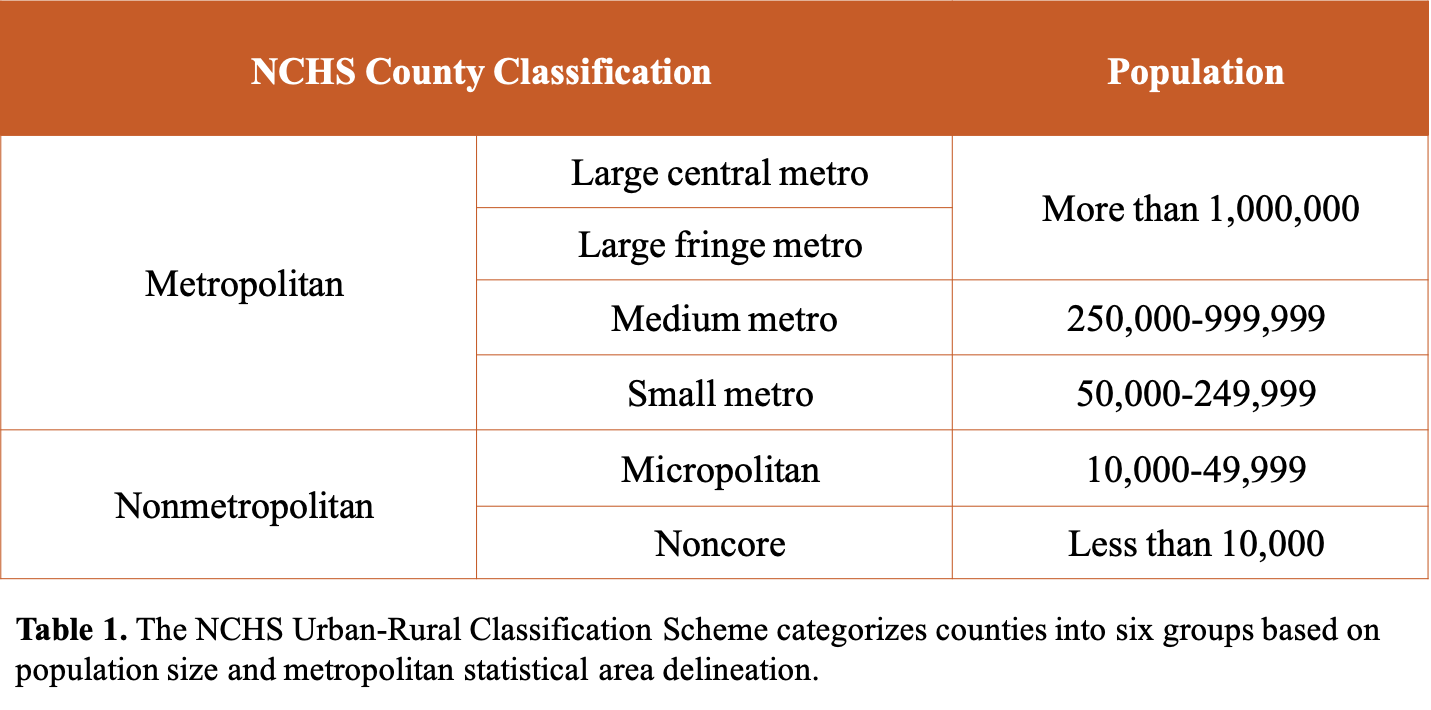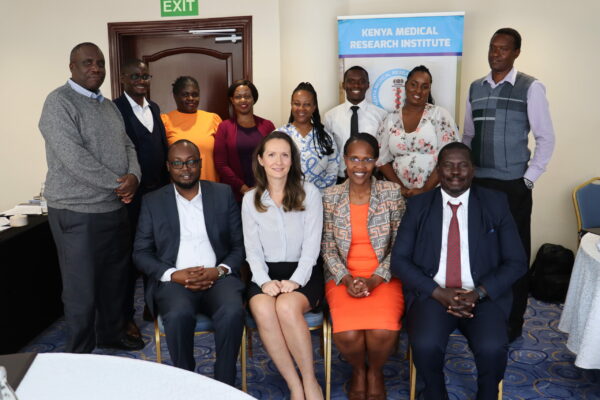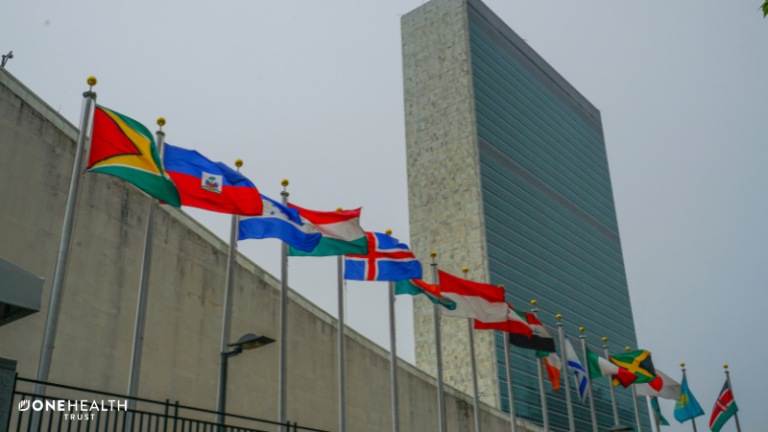November 17, 2020
On ResistanceMap, CDDEP graphs cumulative and daily COVID-19 cases and deaths for the United States by state, combined statistical area, and urbanization level, as well as daily hospitalizations by state. Most recent data show noncore and micropolitan counties leading over large and medium metro counties in daily cases and deaths per 100,000 population.
 In the spring of 2020, large metropolitan areas, such as New York, Detroit, and New Orleans, were the regions hardest hit by the COVID-19 pandemic in the United States. In the summer, daily cases fell in most large cities, even as the SARS-CoV-2 virus that causes COVID-19 spread across the country. Hospitalizations, though high, remained manageable in most states. Now in November, the US is seeing a massive resurgence with over 155,000 new infections per day and over 75,000 people currently hospitalized. However, large metro areas are no longer the places with the highest rates of confirmed cases and deaths. More rural counties are now surpassing urban counties in rates of daily confirmed cases, showing that community spread is no longer a population density issue.
In the spring of 2020, large metropolitan areas, such as New York, Detroit, and New Orleans, were the regions hardest hit by the COVID-19 pandemic in the United States. In the summer, daily cases fell in most large cities, even as the SARS-CoV-2 virus that causes COVID-19 spread across the country. Hospitalizations, though high, remained manageable in most states. Now in November, the US is seeing a massive resurgence with over 155,000 new infections per day and over 75,000 people currently hospitalized. However, large metro areas are no longer the places with the highest rates of confirmed cases and deaths. More rural counties are now surpassing urban counties in rates of daily confirmed cases, showing that community spread is no longer a population density issue.
On ResistanceMap, we have examined how rates have changed across counties categorized by the six urbanization levels outlined in the National Center for Health Statistics (NCHS) Urban-Rural Classification Scheme (Table 1).

In March, the rate of daily cases was highest in the most urbanized counties and lowest in noncore counties. The order is now reversed completely. Noncore and micropolitan counties are seeing over 60 daily confirmed cases per 100,000 population, compared to roughly 40 in large central metro and large fringe metro counties (data from November 15, 2020).
Some states do not have any large or medium metro counties (Table 2). Four of these (North Dakota, South Dakota, Iowa, and Nebraska) are now leading the country in cumulative cases per 100,000, surpassing states like New York and California by over 4,000 per 100,000 population. Some states have seen drastic increases in new cases in the last two weeks alone. For example, Maine, with a population of approximately 1.3 million, reported a 213% increase of daily new cases on November 12 compared to the average 14 days prior.
States with smaller counties are also seeing significant increases in deaths and hospitalizations. North Dakota has surpassed the District of Columbia in cumulative deaths per 100,000 (98 versus 92), and South Dakota is not far behind (71). The Dakotas are currently leading the nation in daily deaths per 100,000. On November 16, North Dakota and South Dakota saw 53 and 62 current hospitalizations per 100,000, respectively, compared to 10 in New York, 11 in California, and 14 in the District of Columbia.

An increasing number of COVID-19 patients are coming from rural areas. Across the country, approximately one in four deaths from COVID-19 is now reported in a rural county. Sharply rising numbers are testing the limits of smaller hospital systems. Hospitals in small metro counties are likely to have fewer ICU beds and fewer healthcare workers than hospitals in large and medium metro counties. Residents of noncore and micropolitan counties may need to travel several hours to get to the nearest hospital, which may be in another state. Once rural hospitals reach capacity, residents will be forced to travel to bigger cities. According to the New York Times, a hospital in Idaho warned it may need to send patients to Seattle and Portland. More states, including Wisconsin and Utah are opening field hospitals, and El Paso, TX has needed to open mobile morgues.
Even though cases, deaths, and hospitalizations are rising in noncore and micropolitan counties, resentment towards public health prevention measures remains. In the early months of the pandemic, the nation saw pushback from rural counties regarding restrictions to reduce virus spread, such as stay-at-home orders. With very few (sometimes zero) cases in their counties, residents argued against business and school closures due to the economic and social consequences. Many also expressed anti-mask sentiments with protests occurring across the country. While evidence indicates mask-wearing is effective in reducing SARS-CoV-2 transmission, the politicization of this public health measure intensified in the wake of the presidential election.
Until a vaccine is widely distributed, public health strategies are the only means of reducing morbidity and mortality of the virus. These include social distancing, wearing masks, washing hands, restricting large gatherings, and restricting indoor gatherings. CDDEP research investigating the relationship between humidity, mobility, and COVID-19 indicates daily cases will increase in colder states during the winter when humidity drops and people spend more time indoors.
Without implementation and enforcement of public health prevention measures, increased hospital capacity, and behavioral changes, the effect of COVID-19 in rural counties of the United States will be catastrophic in the months to come.











